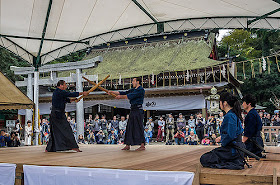 | ||
| What details do you look for when you see a photo like this? Photo Copyright 2014 Grigoris Miliaresis |
We had a really good keiko on Saturday. It was a regular Saturday practice. That is to say it we worked hard, sweat a lot of details, had great fun, and occasionally overloaded someone’s mind..
Sweating the details is the essence of practice. Sometimes it’s the same detail over and over. When you see that, you know you’ve got something fundamental to work on.
I jokingly told Rolf that I was going to give him the same correction on everything he did and then I nearly did it. We started talking about grip while practicing kihon waza (fundamental techniques), and it just snowballed from there.
We always start practice by reviewing the fundamental techniques of jodo. There are only 12 of them, so this serves as a good way to get our muscles warmed up and loose, while putting in some practice on the most essential techniques. Shinto Muso Ryu is a weapons art, so the connection between the practitioner and the weapon is critical. As in so many things in budo, there are a million ways to do it wrong, and one way to do it right.
In jodo, power is transferred from the practitioner to the weapon through their connection at the hand using the last two fingers of the base hand. The jo is a deceptively simple looking weapon. That simplicity makes using it very complex, because you can move your hands anywhere along the weapon and even switch them around. Because the grip is mobile, it’s easy to start well and finish badly.
The grip is integral to every technique, and it’s easy to mess up. Holding and swinging a jo doesn’t look complicated. The grip is a small thing, like the tiny hinges on a huge door. If the hinges are just a little out alignment, good luck moving the door. Just as the hinges connect a door to its frame and allow it to move smoothly and easily, the grip is the connection between your body and the jo. In addition, it is the conduit by which power is transmitted from your body to the jo and from there into your training partner.
The grip is based, not in the thumb and forefinger as you might guess, but in the 5th and 4th fingers. The ones we think of as being the weakest, when used properly are the strongest. Using them properly is the trick. Using your fingers and palm properly is a complex task, and it’s one that you have to do unconsciously. If you have to think about the proper position and use of your fingers, you will be in trouble as soon as your attention is pulled in some other direction.
These small details have to be at the level of unconscious mastery before you can really begin working on the larger elements. Fortunately, most problems with grip are easy to identify when you see them being made. Using the thumb and forefinger instead of the 5th and 4th fingers. Or having your arm perpendicular to the line of the jo. Gripping too tightly. Bending your wrist too much. Thumb out of place.
You may have heard the saying “Don’t sweat the small stuff.” In budo we sweat the small stuff. The longer I do this, the more I realize that it’s all small stuff. All of the big problems have their origins in small details like the grip. That’s why we find ourselves coming back time after time to the small stuff. What angle should my foot be for the entry to harai goshi? How do I squeeze the sword with my little finger for kiri oroshi? What angle should my hips be when doing kaeshi tsuki? How do I grip the jo for honte uchi? These are all part of building a good budo structure, but each is such a small detail we easily look past it when trying to understand what is happening.
Big techniques look impressive and grab our imagination. Harai goshi is a huge throw.
But it’s built on many small details. How you grip is as important for harai goshi as it is for doing anything with a jo. The angle of your feet as you enter and set your body. The position of your hands and arms in relation to your chest can determine the success or failure of the technique. Are you on your heels, or the balls of your feet. Each is a relatively small detail, and yet each one is critical enough to ruin the technique if done wrong.
When I started judo and jodo, I saw the big techniques, the huge throws and powerful strikes. They were thrilling to watch. Through practice, my eyes have learned to see the details that make up the big techniques, and it’s the small things that amaze me now. These days I may not notice which throw someone does because I’m focused on the subtle way the are disrupting their partners structure. When I watch jodo, I know where the strike is going. What I am trying to steal when I watch senior teachers is how they are generating the power for the strike and how they are controlling it.
The small details have big effects. So when we train, we sweat the small stuff. Of course, it’s all small stuff.


No comments:
Post a Comment